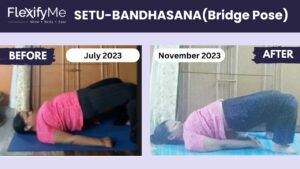Table of Contents
In the hustle of daily life, chronic knee pain is like an unwelcome shadow for many, lingering and limiting. It’s a condition that doesn’t just ache the joints but can dim the joy of simple activities like walking in the park or climbing stairs.
What Is Chronic Knee Pain?
Chronic knee pain is a persistent ache around the knee area that lasts for months. It’s not just a ‘now and then’ discomfort; it’s an ongoing narrative of pain that can rewrite one’s lifestyle. In India, where walking is part of the daily commute for many, chronic knee pain affects a significant number of people, influencing their quality of life.
The Symptoms and Impact
The symptoms aren’t just pain; they can be stiffness, swelling, or a grinding sensation that accompanies every bend. This pain can steal moments—like playing cricket with friends or kneeling for prayers—and can have a ripple effect, touching every part of one’s life.
Why Talk About It?
Because behind every statistic on chronic knee pain, there’s a story. There’s a grandmother in Kolkata who wishes to play with her grandchildren, a young professional in Mumbai who dreads the commute, or a farmer in Punjab for whom the fields have become an arena of endurance.
The Human Side of the Story
Let me share a quick tale. There’s a friend of mine, Ajay, who once ran marathons. Now, he watches them from his balcony, his knees having decided on a different life path. But here’s the thing—Ajay found ways to adapt and manage his condition, and his journey is a beacon of hope for many.
A Call to Step Forward
I encourage you to explore more, ask questions, and interact. There’s a world of resources out there—from medical institutions offering expert opinions to scientific studies that shed light on managing chronic knee pain. And if you’re looking for a starting point, why not check out the free resources available online?
In the next sections, we’ll delve into solutions and strategies, weaving through the realms of medical advice and personal experiences. So, take a seat (comfortably, of course), and let’s talk about turning the page on chronic knee pain, towards a chapter of relief and regained joy.
Understanding the Causes of Knee Pain
Knee pain stems from various issues involving the joint structures like bones, cartilage, ligaments, tendons, and fluid-filled sacs called bursae. Understanding the root cause is key to effective treatment. Let’s explore some of the main culprits:
Osteoarthritis
This degenerative joint disease involves wear and tear of the cartilage cushioning the knee bones. Breakdown of this protective tissue causes bone-on-bone rubbing, swelling, and stiffness. OA accounts for a large portion of chronic knee pain, especially in adults over 50. I know my creaky knees complain after high-impact activities!
Injuries
Sudden injuries from sports or accidents often damage ligaments or the menisci, rubbery discs that cushion the knee. Common examples are ACL tears and meniscal tears. These require prompt treatment and rehab to prevent complications. After my soccer injury, I learned just how vital the ACL is for stability!
Overuse
Repetitive strain on the knees through certain jobs or sports can lead to painful conditions like patellar tendinitis (jumper’s knee), iliotibial band syndrome (runner’s knee), and prepatellar bursitis (housemaid’s knee). Varying activities and rest periods helps minimize overuse.
Rheumatoid Arthritis
This autoimmune disease causes the joints’ inner lining to swell, resulting in fluid buildup and inflammation. The knees are often one of the first places RA manifests. Medications can ease symptoms and hinder progression.
While many factors can contribute to knee pain, the origin tends to involve aging, injury, mechanical stress, or inflammatory disease. Seeking an accurate diagnosis allows you to pursue the right treatment plan for your situation. I encourage you to discuss imaging tests, family history, occupation, and lifestyle habits with your doctor. Understanding the structural cause is empowering. Tell me about your experience uncovering the source of your knee pain below!
Exploring Non-Surgical Options: Yoga as a Powerful Tool
As someone prone to achy knees, I used to avoid yoga entirely, fearing it would aggravate my discomfort. But after research and personal experience, I’m thrilled to share that a customized yoga practice can actually be highly beneficial for relieving joint pain and rebuilding strength.
Under the guidance of an experienced instructor, yoga helps improve flexibility, muscle function, balance, and body awareness. Poses are adapted to avoid compressing the knees. Instead, the focus is on gentle lengthening and controlled movements.
Certain yoga postures even target areas like the hips, glutes, quads, and core to provide stability around the knees. As physical therapist Kelly Richardson explains, “Strengthening the muscles supporting the knees takes pressure off the joint, easing pain.”
A study in the International Journal of Yoga Therapy showed an 80% reduction in knee pain intensity after 8 weeks of tailored yoga among osteoarthritis patients. The mind-body connection is powerful. Yoga helps tune into the body’s needs through careful attention.
Some of my favorite knee-friendly poses include supine hamstring stretch, figure four stretch, bridge pose, and standing warrior II. Remember, props like blocks and straps allow you to modify poses as needed. I also find restorative practices like supported child’s pose and legs up the wall deeply rejuvenating.
It’s best to start very gently, always listening to your body. Avoid forcing knees past a comfortable range of motion or bouncing in and out of poses. Work with a teacher open to adapting postures based on your abilities. Yoga should never exacerbate pain.
A thoughtful yoga sequence 2-3 times per week, paired with light aerobic activity like swimming or walking, makes a world of difference. The key is consistency. Have you tried yoga for knee pain relief? I’d love to hear about your favorite poses and home practice tips in the comments!
When Surgery Becomes the Choice: Understanding Different Procedures
When chronic knee pain starts severely limiting daily activities, surgery may be recommended to repair damage and restore function. The type of surgery depends on the underlying problem, but some main options include:
Arthroscopic Surgery
This minimally invasive procedure involves small incisions for inserting a tiny camera and instruments to visualize and operate inside the joint. Damaged cartilage, meniscus tears, loose bodies, and inflamed synovium can be trimmed or repaired.
As someone who underwent arthroscopic surgery for a torn meniscus, I appreciated the short recovery. It has about a 6 week timeline with gradual return to normal activity. Risks are lower than open surgery, but infection, blood clots, and anesthesia issues can occur.
Total Knee Replacement
Also called arthroplasty, this surgery replaces damaged surfaces of the knee joint with metal and plastic components. It is most commonly done for severe osteoarthritis but may also treat rheumatoid arthritis or major injuries.
Recovery takes about 3-6 months with extensive physical therapy for restoring range of motion and strength. Replacement knees can last 15-20 years in most patients. Possible complications include blood clots, implant failure, and chronic pain, so conservative treatment is preferred initially.
Meniscal Repair Surgery
Instead of removing torn meniscal cartilage, this surgery sews it back together. This preservation technique has high success rates for minor peripheral tears with good blood supply. Rehab focuses on slowly rebuilding strength and ROM.
Knee surgery is a major decision that requires careful consideration of benefits vs. risks. Try all conservative therapies first and have an honest discussion with your orthopedic surgeon regarding expected outcomes. Let me know if you’ve had knee surgery and how recovery went in the comments below!
Weighing the Options: Making an Informed Decision
With many options available, from yoga to medications to surgery, deciding how to best manage your knee pain can feel overwhelming. It’s a very personal choice based on your health history, symptoms, lifestyle factors, and willingness to try different therapies. Here are some key considerations as you weigh your options:
– Severity of pain and loss of function – Mild instability or soreness may respond well to yoga, while significant bone damage causing immobility may require surgery.
– Type of damage and cause – Your doctor can assess this through imaging tests and a physical exam to determine if any tissues need repairing surgically.
– Age and activity level – Younger patients often benefit more from reconstruction procedures for injuries to restore normal movement. Older or less active people may opt for joint replacement.
– Commitment to conservative therapies – Try more invasive solutions only after giving nonsurgical treatments like physical therapy, yoga, braces, medication, and injections a fair shot.
– Personal preferences – Factor in your views on surgery, tolerance for medications, willingness to modify activities, and lifestyle to accommodate recovery.
– Doctor’s recommendation – Have an open and honest discussion with your orthopedic surgeon regarding expected outcomes, rehab needs, risks, and alternatives. Get a second opinion if unsure.
The decision should be made thoughtfully in consultation with your care team. I encourage creating a pros and cons list and asking questions to become fully informed. With the right treatment customized to your needs and diligent self-care, relief from knee pain is within reach. Let me know your thoughts on the options and if you have any other questions!
Living With Knee Pain: Staying Positive and Finding Your Path
If you live with chronic knee pain, life can feel like an uphill battle at times. The constant discomfort and loss of mobility can take an emotional toll, leaving you feeling frustrated, hopeless, or withdrawn. However, it is possible to reclaim meaning and joy, even while managing ongoing knee issues. The key is staying focused on what you can control and seeking the right support.
First, concentrate on maintaining a positive mindset. When pain flares up, avoid catastrophizing language like “this is awful” or “I can’t take it anymore.” Instead, tell yourself, “This will pass. I can handle it.” Celebrate small wins, enjoy humor where you find it, and express gratitude for what your body can still do. A 2014 study confirmed that knee osteoarthritis patients with a positive outlook reported higher life satisfaction and ability to manage pain.
Second, understand you don’t need to just “live with” knee pain without support. Chronic conditions often require a team approach combining various therapies for optimal relief. Alongside strength training, medication, or assistive devices, consider exploring complementary options like acupuncture, massage, mindfulness practices, or online mental health support.
For example, FlexifyMe offers conveniently accessible guided yoga sessions, coping strategies, and video calls with licensed therapists—right from home. Their holistic, personalized programs aim to reduce pain perception while also addressing related anxiety, depression, isolation, or sleep disruption.
The path towards knee pain relief looks different for everyone. But with consistent self-care, social support, professional guidance, and most crucially—hope—you can find your way to a rich, fulfilling life. The pain may not fully disappear, but your ability to thrive in spite of it can grow tremendously. You’ve got this! Now is the time to take that first step.


